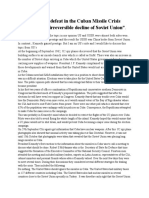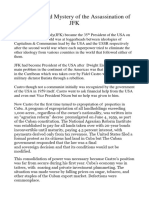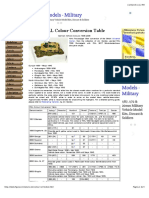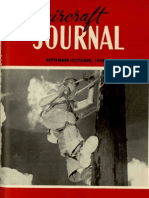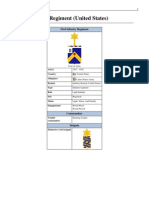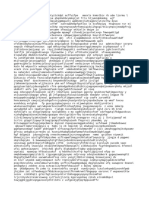Apush Cuba
Apush Cuba
Uploaded by
kazstreborCopyright:
Available Formats
Apush Cuba
Apush Cuba
Uploaded by
kazstreborOriginal Description:
Original Title
Copyright
Available Formats
Share this document
Did you find this document useful?
Is this content inappropriate?
Copyright:
Available Formats
Apush Cuba
Apush Cuba
Uploaded by
kazstreborCopyright:
Available Formats
-----Intro------
After Castros communist takeover of Cuba Premier Khrushchev of Russia sent Anastas Mikoyan to meet with the new leader. Although Mikoyan came back with positive reviews for the Cuban government the Soviets were still weary of this new leader.1 The US placed an embargo on Cuban economic goods after US interest were nationalized following the rise of the communist government. This is what started the increasing relations between Cuba and the USSR. After the embargo was set Cuba had a large supply of sugar and nobody to sell it to, so they asked the Soviets for help. At the end of May 1962, the Soviets sent nuclear missiles to Cuba in response to the failed attempt of the US to take down the Cuban Communist government. The Soviets felt that they must gain an upper hand due to the US missiles in neighboring Turkey and the US nuclear superiority that was 9:1, while also lending a hand to the new ally of the USSR.2 Cuba being the new found ally to the USSR culminated an increased in surveillance by the United States government. In October 1962, an American spy plane photographed Soviet missiles in Cuba.3 On October 16, 1962 president John F. Kennedy called in a group of his closest advisors. The group discussed the information provided by the CIA that showed Soviet missile installations in Cuba. The group was presented with three options, open surveillance, an embargo of weapons entering Cuba, and a military attack against the missile installations.4 The idea of open surveillance was seen as being an ineffective strategy and it could lead to a possible escalation of US and Soviet tensions. The military attack against Cuba was seen as a worst case scenario, the focus on airstrikes would have definitely killed Soviet troops
Roberts 2 and the large possibility of not destroying all the missiles installations would have spelled certain doom for the US. The final option of an embargo was the choice with the highest probable success rate, so it was chosen by the president. The aim of the embargo was to keep the USSR from bringing in more military supplies, and provide a bargaining chip for the removal of Soviet missiles and the destruction of the missile sites. 5This bargaining chip proved to be very successful, on October 24 Soviet vessels approach the US blockade but turned back. This event got president Kennedy to respond letters from Soviet premier Nikita Khrushchev and start negotiations to end the crisis.6 The final deal that Kennedy and Khruschev publically agreed to included provisions that the USSR would dismantle the Cuban missile sites in exchange for the US ending the blockade and a promise not to invade Cuba. The two leaders also privately agreed that the US would remove its missile bays from Turkey.7 The details of the Cuban embargo completely shut off all trade with Cuba; the embargo kept all non-humanitarian goods out of Cuba, banned all Cuban goods in the US, and blacklisted ships that carried cargo to and from Cuba.8 The embargo did have negative effects on the US economy the GDP growth rate in the years before 1963 averaged around five percent, while the year of the embargo the growth rate stalled around two percent during the fourth quarter of the year.9 Even with the GDP drop the embargo on Cuba did not affect US import/export amounts in a negative way, in fact US exports grew by$1.9 billion and US imports grew by $1.05 billion10 this means that the Cuban embargo did not affect the US economy besides a short term sugar price rise, but that was solved after other South American nations expanded their sugar production.
Roberts 3 Works Cited "United States GDP Growth Rate." TRADING ECONOMICS | 300.000 INDICATORS FROM 196 COUNTRIES. http://www.tradingeconomics.com/united-states/gdpgrowth (accessed April 20, 2013). Amnesty International. "Amnesty USA." THE US EMBARGO AGAINST CUBA ITS IMPACT ON ECONOMIC AND SOCIAL RIGHTS. www.amnestyusa.org/pdfs/amr250072009eng.pdf (accessed March 21, 2013). BUREAU OF WESTERN HEMISPHERE AFFAIRS. "Cuba." U.S. Department of State. http://www.state.gov/r/pa/ei/bgn/2886.htm (accessed March 21, 2013). Commission on Behavioral and Social Sciences and Education. "International Conflict Resolution After the Cold War." The National Academies Press. http://www.nap.edu/openbook.php?record_id=9897&page=123 (accessed March 22, 2013). George Washington University. "The Cuban Missile Crisis, 1962: A Political Perspective After 40 Years." National Security Archive The George Washington University. http://www.gwu.edu/~nsarchiv/nsa/cuba_mis_cri/ (accessed March 31, 2013). J, Sierra . "Economic Embargo Against Cuba." Cuban history begins here. http://www.historyofcuba.com/history/funfacts/embargo.htm (accessed March 27, 2013). JOHN F. KENNEDY PRESIDENTIAL LIBRARY AND MUSEUM. " Cuban Missile Crisis - John F. Kennedy Presidential Library & Museum." John F. Kennedy
Presidential Library & Museum. http://www.jfklibrary.org/JFK/JFK-inHistory/Cuban-Missile-Crisis.aspx (accessed March 25, 2013). Khrushchev , Sergei. "How My Father And President Kennedy Saved The World |
Roberts 4
American History Lives at American Heritage ." American History Lives at American Heritage . http://www.americanheritage.com/content/how-my-fatherand-president-kenedy-saved-world (accessed April 21, 2013). Lee, Brianna. "The Frozen U.S.-Cuba Relationship." Council on Foreign Relations. www.cfr.org/cuba/frozen-us-cuba-relationship/p27510 (accessed March 21, 2013). "Office of the Historian - Milestones - 1961-1968 - The Bay of Pigs and the Cuban Missile Crisis." Office of the Historian. http://history.state.gov/milestones/19611968/CubanMissile (accessed April 1, 2013). Schott, Jeffrey, Kimberly Elliott, Milica Cosic, and Gary Hufbauer. "Case Studies in Economic Sanctions and Terrorism Case 60-3 US v. Cuba (1960 : Castro)." Peterson Institute for International Economics. www.iie.com/publications/papers/sanctions-cuba-60-3.pdf (accessed March 22, 2013). Suddath, Claire. "A Brief History Of U.S.-Cuba Relations - TIME." Breaking News, Analysis, Politics, Blogs, News Photos, Video, Tech Reviews - TIME.com. http://www.time.com/time/nation/article/0,8599,1891359,00.html (accessed March 21, 2013). "U.S. Trade in Goods and Services - Balance of Payments (BOP) Basis." Census.gov. www.census.gov/foreign-trade/statistics/historical/gands.txt (accessed April 20, 2013). Woolley, John. "Proclamation 3447 - Embargo on All Trade with Cuba." The American Presidency Project. http:/http://www.presidency.ucsb.edu/ws/?pid=58824
Roberts 5
(accessed March 24, 2013).
1 2
Khrushchev, How My Father And President Kennedy Saved The World, 1 Khrushchev, 2 3 John F. Kennedy Presidential Library & Museum, ://www.jfklibrary.org/JFK/JFK-in-History/CubanMissile-Crisis 4 George Washington University, http://www.gwu.edu/~nsarchiv/nsa/cuba_mis_cri/
5 6
John F. Kennedy Presidential Library & Museum Office of the Historian http://history.state.gov/milestones/1961-1968/CubanMissile 7 John F. Kennedy Presidential Library & Museum
8 9
J, Sierra . Economic Embargo Against Cuba Trading Economics, http://www.tradingeconomics.com/united-states/gdp-growth 10 Census, U.S. Trade in Goods and Services
You might also like
- The Devil To Pay in The Backlands - João Guimarães Rosa PDFDocument254 pagesThe Devil To Pay in The Backlands - João Guimarães Rosa PDFPegleg Watermelon Fillmore91% (11)
- Dominik Geppert, William Mulligan, Andreas Rose-The Wars Before The Great War - Conflict and International Politics Before The Outbreak of The First World War-Cambridge University Pres PDFDocument392 pagesDominik Geppert, William Mulligan, Andreas Rose-The Wars Before The Great War - Conflict and International Politics Before The Outbreak of The First World War-Cambridge University Pres PDFRoberto Rodriguez Flores100% (2)
- A1 Av8bb Tac 000 PDFDocument800 pagesA1 Av8bb Tac 000 PDFrhino1100% (2)
- Annotated BibliographyDocument15 pagesAnnotated Bibliographyaaron_hamilton42017No ratings yet
- Chrony Manual V2Document3 pagesChrony Manual V2btvs22magNo ratings yet
- Cuban Missile Crisis Actual PDFDocument8 pagesCuban Missile Crisis Actual PDFhimani prajapatiNo ratings yet
- Cuban Missile Crisis Thesis IdeasDocument7 pagesCuban Missile Crisis Thesis Ideasalyssadennischarleston100% (2)
- The Cuban Missile CrisisDocument8 pagesThe Cuban Missile Crisissweetie2blueNo ratings yet
- History Course WorkDocument3 pagesHistory Course WorkRauf GaralovNo ratings yet
- 03 Cuban Missile CrisisDocument3 pages03 Cuban Missile CrisisMajeed AkinlusiNo ratings yet
- Cuba and The Cold WarDocument10 pagesCuba and The Cold WarKashish SharmaNo ratings yet
- Annotated Bibliography 4 MlaDocument6 pagesAnnotated Bibliography 4 Mlaapi-244911166No ratings yet
- FP Cuban Missile Crisis AssignmentDocument9 pagesFP Cuban Missile Crisis AssignmentAfolabi QauzeemNo ratings yet
- Cuban Missile Crisis and Its ImplicationsDocument12 pagesCuban Missile Crisis and Its Implicationsalex.noorNo ratings yet
- History - The Cuban Missile CrisisDocument2 pagesHistory - The Cuban Missile CrisisMegan TaylorNo ratings yet
- History Essay Cuban Missile CrisisDocument6 pagesHistory Essay Cuban Missile CrisisGheitanNo ratings yet
- Thesis Statements For The Cuban Missile CrisisDocument4 pagesThesis Statements For The Cuban Missile Crisispzblktgld100% (1)
- Cuban Missiles CrisisDocument2 pagesCuban Missiles CrisisEdu PurposeNo ratings yet
- NHD Research PaperDocument14 pagesNHD Research Paperapi-461594391No ratings yet
- Cuban Missile CrisisDocument32 pagesCuban Missile Crisisd.romimilaNo ratings yet
- Cuban Missile Crisis Research Paper ThesisDocument6 pagesCuban Missile Crisis Research Paper Thesisafknvhdlr100% (2)
- History Cuban Crisis ProjectDocument10 pagesHistory Cuban Crisis ProjectGodlyidiot D. VimalNo ratings yet
- Issue 3 The Cuban Missile Crisis LRDocument70 pagesIssue 3 The Cuban Missile Crisis LRavagreig0610No ratings yet
- Research Paper The Cuban Missile CrisisDocument6 pagesResearch Paper The Cuban Missile Crisisapi-512512524No ratings yet
- Mil Hist - CW Other Cuban Crisis, TheDocument10 pagesMil Hist - CW Other Cuban Crisis, TheDonnieNo ratings yet
- Final ProjectDocument9 pagesFinal ProjectCaleb thomasNo ratings yet
- Procurement AnalysisDocument30 pagesProcurement Analysisasit chatterjeeNo ratings yet
- Actual Work CitedDocument4 pagesActual Work Citedapi-343788621No ratings yet
- 25 Page Research Paper RevisedDocument22 pages25 Page Research Paper Revisedapi-253598811No ratings yet
- Cuban Missile CrisisDocument26 pagesCuban Missile Crisismoschub100% (2)
- CubanDocument1 pageCubanVarsha RNo ratings yet
- NHD BibliographyDocument7 pagesNHD Bibliographyapi-491914818No ratings yet
- How Effectively Did The USA Contain The Spread of CommunismDocument9 pagesHow Effectively Did The USA Contain The Spread of CommunismPeranut YlNo ratings yet
- Cuban Missile CrisisDocument22 pagesCuban Missile CrisisNishant NeogyNo ratings yet
- Cuban Missile Crisis Thesis StatementDocument5 pagesCuban Missile Crisis Thesis Statementmeghanhowardmanchester100% (2)
- Quick Guide - Cuban Missile CrisisDocument1 pageQuick Guide - Cuban Missile Crisiskinmanchan2015No ratings yet
- The Cold War & US Diplomacy (Final Draft) 4/30/2012Document6 pagesThe Cold War & US Diplomacy (Final Draft) 4/30/2012KT100% (1)
- Cuban Missile Crisis Thesis QuestionsDocument7 pagesCuban Missile Crisis Thesis Questionstammymitchellfortwayne100% (2)
- The Cold WarDocument8 pagesThe Cold WarDennis Lobo100% (1)
- At the Edge of the Abyss: A Declassified Documentary History of the Cuban Missile CrisisFrom EverandAt the Edge of the Abyss: A Declassified Documentary History of the Cuban Missile CrisisRating: 5 out of 5 stars5/5 (1)
- Thesis For A Paper On The Cuban Missile CrisisDocument7 pagesThesis For A Paper On The Cuban Missile Crisisdnhrm565100% (2)
- Causes of The Cuban Missile CrisisDocument10 pagesCauses of The Cuban Missile CrisisfocusedstudyingurlsNo ratings yet
- Korean Crisis: Cold War Warm War America Russia Communist China World War TwoDocument9 pagesKorean Crisis: Cold War Warm War America Russia Communist China World War TwoHumera FatimaNo ratings yet
- Cold War 2Document5 pagesCold War 2RoopeshNo ratings yet
- ACFrOgD0iEbo8 CgeGNxwk XEQZYUjBjDKbL909ehpl1HqlQAe25bElFuaUJSlrgIdLELAC8Wt5udsN PM E4cVV22epiFdig3t49Rf9zfUnJpkkDdxVALKbvJIB9Vxnuh XFJBFH MdXyQ5BaMbDocument6 pagesACFrOgD0iEbo8 CgeGNxwk XEQZYUjBjDKbL909ehpl1HqlQAe25bElFuaUJSlrgIdLELAC8Wt5udsN PM E4cVV22epiFdig3t49Rf9zfUnJpkkDdxVALKbvJIB9Vxnuh XFJBFH MdXyQ5BaMbMAVERICK ZHAO YINRAN HCINo ratings yet
- The Cuban Missle Crisis SummaryDocument1 pageThe Cuban Missle Crisis SummarymattjagNo ratings yet
- The Cuban Missile Crisis October 1962Document2 pagesThe Cuban Missile Crisis October 1962Idrissa BachirouNo ratings yet
- Thesis Cuban Missile CrisisDocument5 pagesThesis Cuban Missile CrisisPaySomeoneToWritePaperUK100% (2)
- SSS - Cold War - The Cuban Missile CrisisDocument25 pagesSSS - Cold War - The Cuban Missile CrisisGMPG STUDIOSNo ratings yet
- The Cuban Missile Crisis: How Did Our World Manage To Avoid The Third World War?Document10 pagesThe Cuban Missile Crisis: How Did Our World Manage To Avoid The Third World War?Зелёная ЗаряNo ratings yet
- Cuban Missile Crisis - Book NotesDocument13 pagesCuban Missile Crisis - Book NotesMatty Burgess ッNo ratings yet
- Cuban Missle CrisisDocument3 pagesCuban Missle CrisiscaetispogNo ratings yet
- Essay Question Analyse The Part Played by Cuba in The Development of The Cold War.Document2 pagesEssay Question Analyse The Part Played by Cuba in The Development of The Cold War.chl23No ratings yet
- Annotated BibliographyDocument13 pagesAnnotated BibliographyleeukbNo ratings yet
- James Nathan - Cuban Missile Crisis RevisitedDocument39 pagesJames Nathan - Cuban Missile Crisis RevisitedXupi AlexNo ratings yet
- President John F. Kennedy's Inaugural Address Friday, January 20, 1961Document3 pagesPresident John F. Kennedy's Inaugural Address Friday, January 20, 1961Tanish KothariNo ratings yet
- ReportDocument5 pagesReportapi-358359361No ratings yet
- Essay InsDocument3 pagesEssay InsZemmerCCNo ratings yet
- Cuban Missile CrisisDocument14 pagesCuban Missile CrisisDantiNo ratings yet
- Cuban Research PaperDocument8 pagesCuban Research Paperjppawmrhf100% (1)
- JFK Unsolved MysteryDocument8 pagesJFK Unsolved Mysteryअनामिक मिमांसाNo ratings yet
- The Cuban Missile CrisisDocument8 pagesThe Cuban Missile CrisisJaja babitNo ratings yet
- Detente SummaryDocument15 pagesDetente SummaryIsmail M HassaniNo ratings yet
- Salary Grade 3rd PhilippinesDocument6 pagesSalary Grade 3rd PhilippinesMelonie Nueva0% (1)
- Defence Management BudgetDocument5 pagesDefence Management BudgetnadiaNo ratings yet
- UltraModern5 - REDUX - Errata - PATCH Ver. 1.6 (2020-11-06)Document3 pagesUltraModern5 - REDUX - Errata - PATCH Ver. 1.6 (2020-11-06)Doyle WestNo ratings yet
- Arab-Israeli Conflict Today 2Document37 pagesArab-Israeli Conflict Today 2xxinyee100% (1)
- Testing Magnetic CompassDocument4 pagesTesting Magnetic Compassprofux0% (1)
- The Following Are Pointers To ReviewDocument7 pagesThe Following Are Pointers To ReviewDonnie Ray Olivarez SolonNo ratings yet
- Colonization of The Sub ContinentDocument21 pagesColonization of The Sub Continentpsychology assignmentNo ratings yet
- Sylhet Libaration WarDocument16 pagesSylhet Libaration WarSyeda Ashifa Ashrafi PapiaNo ratings yet
- Fidelis Models - Military: RAL Colour Conversion TableDocument4 pagesFidelis Models - Military: RAL Colour Conversion TableEdwin Alcalde HuamanNo ratings yet
- Martyred Intellectuals Day Special PageDocument1 pageMartyred Intellectuals Day Special PageDhaka TribuneNo ratings yet
- Anti-Aircraft Journal - Oct 1949Document68 pagesAnti-Aircraft Journal - Oct 1949CAP History LibraryNo ratings yet
- 05-03 Parashat Eikev - As A ResultDocument37 pages05-03 Parashat Eikev - As A ResultEl Zyan MevarechNo ratings yet
- Uzzal Sir MatricesDocument53 pagesUzzal Sir MatricesAbdun NafiNo ratings yet
- Reporting Atrocities Archibald Reiss in PDFDocument23 pagesReporting Atrocities Archibald Reiss in PDFRupomir SajberskiNo ratings yet
- Boris PasternakDocument176 pagesBoris Pasternakhyacintum100% (1)
- The Green Corridor by Srdja TrifkovicDocument18 pagesThe Green Corridor by Srdja TrifkovicJelena Popovic VasicNo ratings yet
- Marquages, Codes Allemands Pour Dates de Fabrication Heckler Und KochDocument6 pagesMarquages, Codes Allemands Pour Dates de Fabrication Heckler Und KochClaude CaiafaNo ratings yet
- 53rd Infantry Regiment (United States)Document4 pages53rd Infantry Regiment (United States)pcojediNo ratings yet
- Noolagam Thiru Vi Ka Thayumanavar Adikalar Mooligai Karthi 19 - QPDocument20 pagesNoolagam Thiru Vi Ka Thayumanavar Adikalar Mooligai Karthi 19 - QPAdam SafiNo ratings yet
- Austro-Hungarian Army Aircraft of World War One (Peter M. Grosz, George Haddow, Peter Schiemer)Document83 pagesAustro-Hungarian Army Aircraft of World War One (Peter M. Grosz, George Haddow, Peter Schiemer)AdrianKosturiNo ratings yet
- RoninDocument3 pagesRoninzua mãeNo ratings yet
- Blackbeardsdoom CLRDocument7 pagesBlackbeardsdoom CLRCody KlintworthNo ratings yet
- AMCP 706-140 Trajectories, Differential Effects, and Data For ProjectilesDocument59 pagesAMCP 706-140 Trajectories, Differential Effects, and Data For ProjectilesNordavind100% (3)
- A Diary of Great Filipino Men and Women ALPHABETICALDocument4 pagesA Diary of Great Filipino Men and Women ALPHABETICALMario Llobrera Flores IINo ratings yet
- SavijpzzongenbjdyjvkDocument155 pagesSavijpzzongenbjdyjvkRicardo Yrupailla MezaNo ratings yet
- European Security and Defence - April 2016 PDFDocument84 pagesEuropean Security and Defence - April 2016 PDFiulbuj100% (1)








